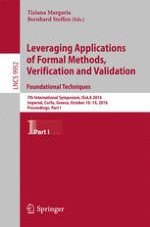The two-volume set LNCS 9952 and LNCS 9953 constitutes the refereed proceedings of the 7th International Symposium on Leveraging Applications of Formal Methods, Verification and Validation, ISoLA 2016, held in Imperial, Corfu, Greece, in October 2016.
The papers presented in this volume were carefully reviewed and selected for inclusion in the proceedings. Featuring a track introduction to each section, the papers are organized in topical sections named: statistical model checking; evaluation and reproducibility of program analysis and verification; ModSyn-PP: modular synthesis of programs and processes; semantic heterogeneity in the formal development of complex systems; static and runtime verification: competitors or friends?; rigorous engineering of collective adaptive systems; correctness-by-construction and post-hoc verification: friends or foes?; privacy and security issues in information systems; towards a unified view of modeling and programming; formal methods and safety certification: challenges in the railways domain; RVE: runtime verification and enforcement, the (industrial) application perspective; variability modeling for scalable software evolution; detecting and understanding software doping; learning systems: machine-learning in software products and learning-based analysis of software systems; testing the internet of things; doctoral symposium; industrial track; RERS challenge; and STRESS.
